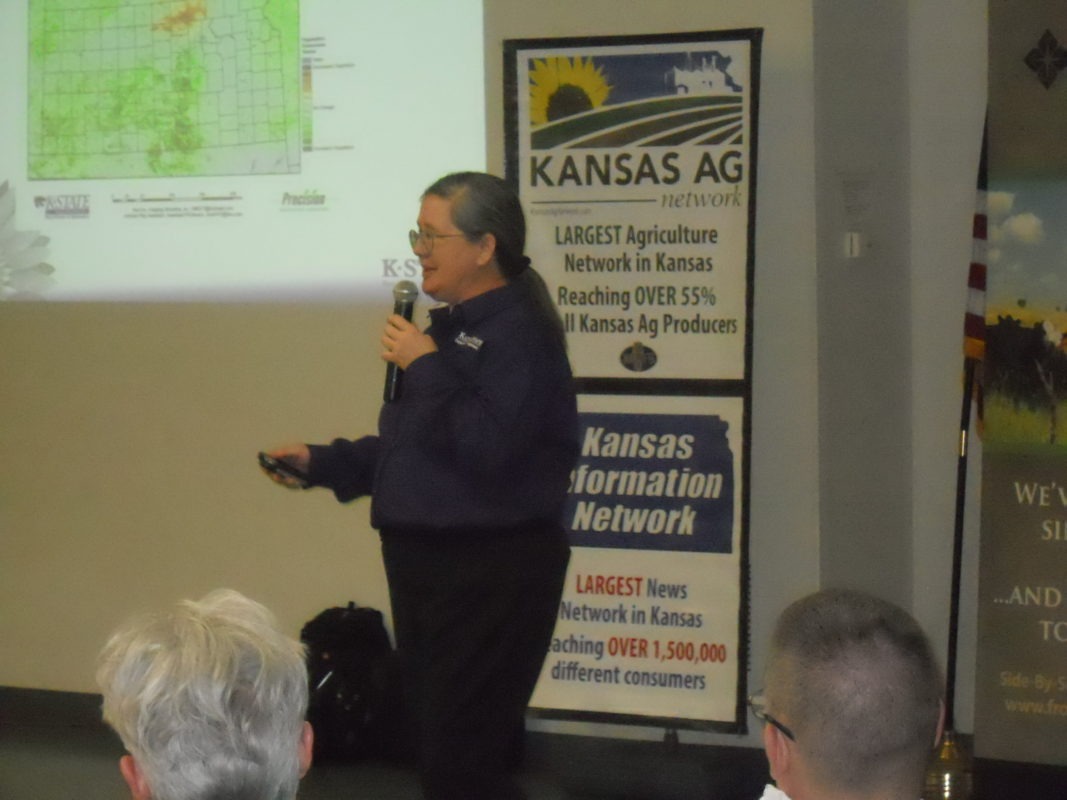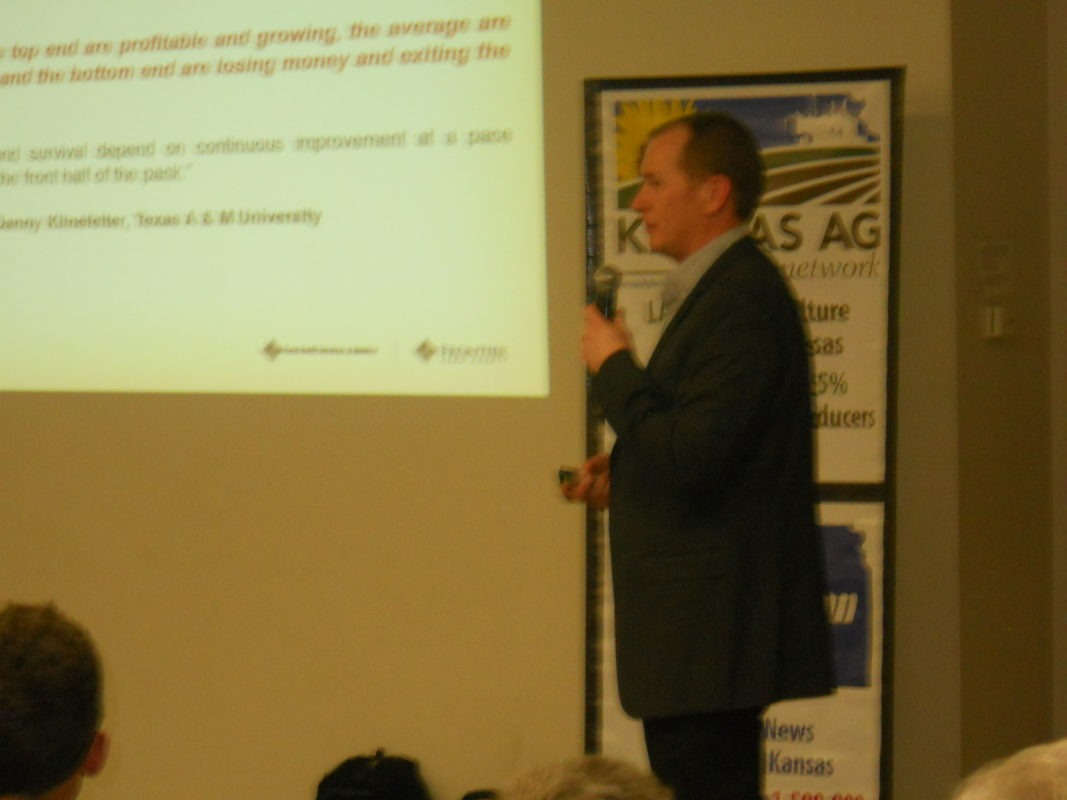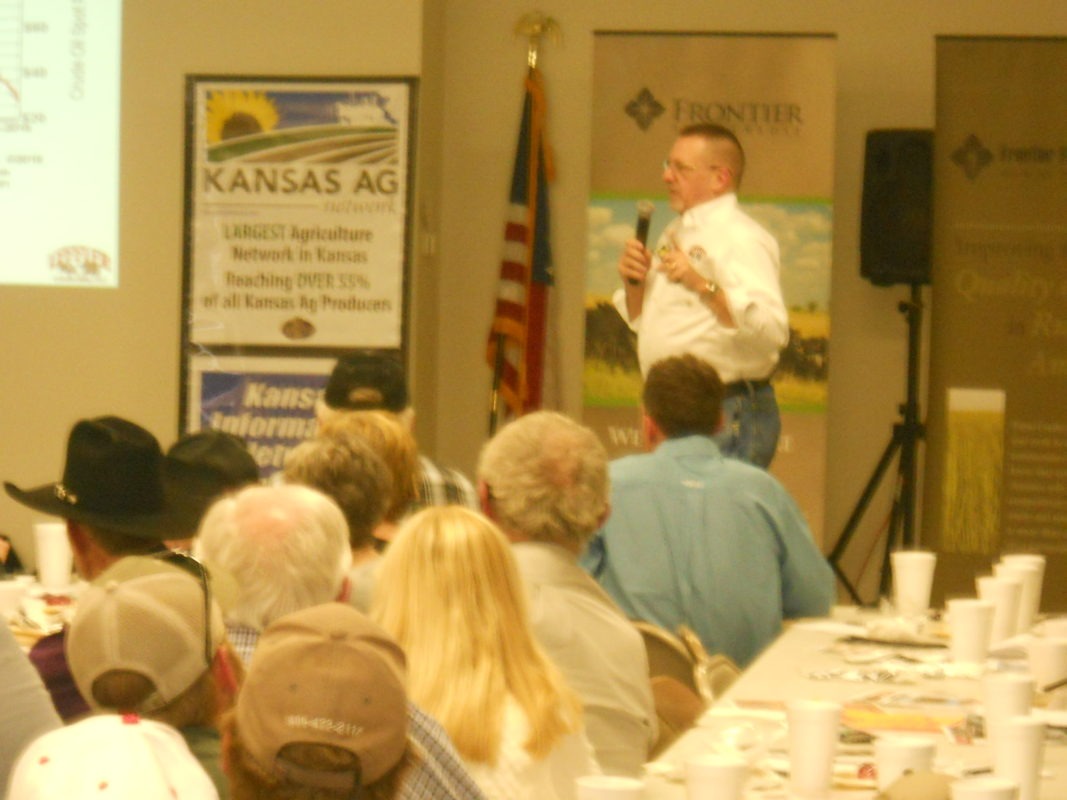Weather, financing and marketing are the biggest dilemmas faced by agriculture producers.
Nothing can be done about the moisture and climatic conditions, except to be aware and make essential adjustments as quickly as possible.
Financing and marketing are a different story in that management decisions can be made to help assure agriculture profitability despite drastically changing conditions.
Assistance for farmers facing these quandaries was provided during the Farm Profit Conference hosted by 580 WIBW, in cooperation with the Greenwood County Extension Service, last Thursday evening at Madison.
“Madison has never seen so many people come to town, has it?” Kelly Lenz, longtime 580 WIBW farm director and program coordinator, welcomed nearly 200 farm-ranch people to the Sauder Community Center.
While Madison’s community celebrations do attract such crowds, the farming community’s population of 671, did surge when agriculture producers from at least a 100-mile radius started gathering as early as3:45, for the 6 o’clock supper program.
And, it was well after 10, before county agent-event cooperator Ryan Schaub had the floors swept and turned off the lights.
Two dozen event sponsors had displays crowded around the room, such there was almost no room to move, but the farm folks were persistent delving for information and wares presented.
Local rancher Matt Perrier of Dalebanks Angus at Eureka serves as president of the Kansas Livestock Association and also welcomed his neighbors from nearby and afar assuring each of services provided by the organization on behalf of profitable beef production.
The Weather Outlook
Temperatures were at all-time highs or nearly so, as strong winds made wildfire awareness alarms statewide, and fright the auditorium door would shatter as guests entered, when Mary Knapp, assistant state climatologist from Kansas State University at Manhattan gave what most attendees viewed as a “positive weather outlook.”
Precipitation in eastern Kansas during the first 45 days of the years\ was less than normal, with temperatures slightly above normal, Knapp’s charts confirmed.
This winter’s vegetative chart, compared to the 26-year average, showed increased vegetation in south central counties, but no change in the bulk of eastern Kansas counties. Four north central Kansas counties had decreased vegetation.
Consequently and fortunately, the current drought monitor showed no problems in Kansas, although Texas, the northeast, the north central states are abnormally dry as is the western part of the country, with some states in extreme and exceptional drought.
Three month spring precipitation outlook, given by Knapp, was near equal for the eastern one-fifth of Kansas, while normal to above normal in the central and western parts of the state.
March outlook is for normal precipitation in eastern Kansas, to above normal in the western one-third of Kansas.
Temperatures are predicted “normal” in Kansas and the southeast United States, but above normal in all of the western and northern part of the country.
Planting season outlook is for normal precipitation in the eastern one-third of Kansas, to above normal for the rest of the state.
“Summer and fall precipitation is impossible to accurately predict, but it is expected to be normal with below normal fall precipitation in southwest Kansas,” Knapp said.
Weather updates are available at http://www.mesonet.ksu.edu/.

Navigating Challenging Times
Sharply lower commodity prices today compared to record highs in the past three years have created challenging times for many agriculture producers, and Chad Gent, vice president of retail credit for Frontier Farm Credit, advised farmers-ranchers on “doing what’s right for your business.”
Today’s farm situation is not like the 1980s, Gent insisted. Majority of the farm debt then was held by less than a third of the operations, while today that debt is held by 4 percent of the operations.
Then, 30 percent of the operations produced 42 percent of net income, while today 4 percent produce 48 percent of the income.
Only a third of farmers had no debt the early ’80s, while in 2012, three-fourth of the operations had no debt.
“In 1981, farmers faced historically high interest rates, with the prime rate of 21 percent, while today we have historically low interest rates, with prime at 3.5 percent,” Gent said.
Most producers in the ’80s had variable interest rates, but now there’s more use of fixed interest rates, with many borrowers having already locked in record-low rates, Gent informed.
Four factors determine business success. “Marketing and production are the key components of margin management, while focusing on solvency and liquidity give farmers the opportunity to withstand industry cycles and take advantage of opportunities,” Gent said.
“Current forecast predicts three years of little help on the price side, so producers must focus on the cost of production to be competitive and profitable” Gent insisted.
While cattle producers have gone from big gains to big losses, Gent pointed out that although feeder cattle prices have dropped significantly, there is still profitability. “Calf numbers are increasing,” he warned.
“Low cost producers with sustainable debt levels will survive and thrive in agriculture,” Gent said.
“Maintain a strong financial position with maximum risk bearing capacity,” the economist recommended.
“Refinance, re-amortization and rebalancing your balance sheet is not an indication of failure, it is a sign of a good financial manager,” Gent stated.
“Be prepared to make adjustments, because there will always be opportunities in agriculture,” Gent declared.

Facing Marketing Reality
With the lower commodity prices, many producers still do not have a marketing plan, according to Tom Leffler of Leffler Ag Consulting, LLC, at Augusta.
As the wrap-up speaker for the Madison conference, Leffler reiterated market declines, asking “How important is marketing to you? Are you able to pull the trigger and sell when it’s time? Who do you listen to, those who say what you want to hear, or those who say what you need to hear?”
Corn yield last year was the second largest in history making the third largest production of all time, with the third largest ending stocks in two decades.
U.S. corn exports were the lowest in 20 years, yet world corn production was the third largest in history. Ethanol production, a major contributor to corn prices, is at record levels, as producers experience “poor margins,” Leffler said.
The United States had record soybean yield last year, with record total production, making the largest ending stocks in two decades.
However, while U.S. soybean exports were the second largest ever, that number was 153 million bushels below the previous year’s record exports, according to Leffler.
“World soybean production last year tied the all-time record, and all-time high production is forecasted for Brazil and Argentina this year,’ Leffler said.
Despite, wheat acreage last year being the second lowest since 1913, along with the lowest hard winter wheat acres since 1957, and U.S. exports the lowest since the early ’70s; U.S. ending wheat stocks remained at the fourth largest in the past two decades, Leffler’s PowerPoint showed.
“There was record world wheat production and record large world ending wheat stocks,” Leffler informed.
To help ease some of these commodity price pressures, Leffler insisted: “Know your cost of production, and understand the use of futures and options, with local current and historical ‘basis.’”
It’s important to write, post and execute a marketing plant utilizing various methods and increments.
“Be a disciplined marketer, and use risk management,” Leffler recommended.
“Do not dwell on past mistakes or decisions, yet have a plan for ‘what if we are wrong?’” he advised.
“Producers must accept that markets are highly unpredictable, yet marketing must be based upon a plan, not emotions,” Leffler affirmed.

